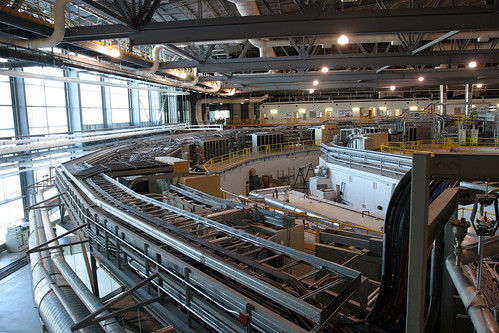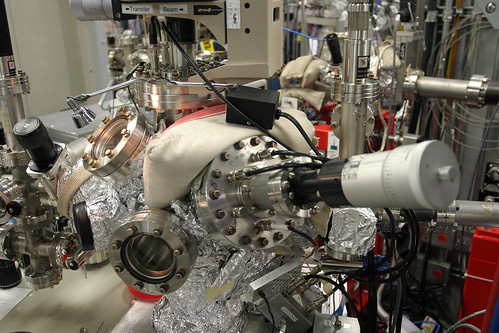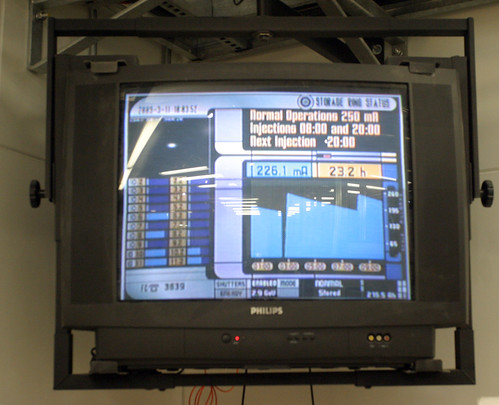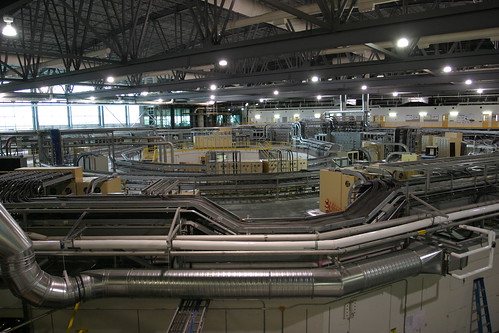Sup peeps! As previously mentioned, here are a few photos from the Canadian Light Source. The CLS is a third generation 2.9 GeV synchrotron located in Saskatoon, Saskachewan. And it's friggin' awesome: 
That's a view of the ring from the north end. The outer donut ring shaped structure is the hutch that covers the storage ring (where electrons go screaming around in a circle, spewing out photons all willy nilly). The inner shaped donut is the injection ring, which spits electrons into the storage ring twice a day to maintain a current of ca. 250 mAmps.
I can't claim to understand much of how synchrotron radiation is produced or the reasons behind its awesomeness, but Wikipedia sure can. For my purposes, synchrotrons are frigging awesome at producing metric buttloads of photons over a huge energy range, making them ideal for any kinds of spectroscopy. Furthermore, they usually are coupled with state-of-the-art optics systems to harness that light, such as monochromators and detectors. This makes science a very happy person.
Positioned tangentially around the outside of the ring, are beamlines optimized to look at certain ranges of photon energies (measured in electron volts) for a range of applications. The CLS has six operational beamlines ranging in energies from the far IR to extremely high energy X-rays (up to 40,000 eV!), with another five almost ready and two more in the wings. This photo above is of the Spherical Grating Monochromator (SGM) and Planar Grating Monochromator (PGM) beamlines, which together cover the soft X-ray energy range (from about 5 to 2000 eV). X-rays are of sufficient energy to cause changes in the electronic state of a material; basically, the photon headbutts a core level electron (like, say, one occupying a 1s orbital), causing it to jump into a valence electron. These transitions require just the right amount of photon energy, depending on the atom and orbitals involved. In the energy range covered by the SGM and PGM beamlines at the CLS, there are a lot of elements that will absorb the X-rays, so much so that the beamline has to be kept under high vacuum so that X-rays will reach your sample. 
The above picture is of the analysis chamber on the PGM. The sample is held in the middle of the vacuum chamber, where incoming photons will hit it, causing X-ray fluorescence or other relaxation events to occur such as Auger electron emission. There are several detectors inside the chamber to record these relaxation events; the X-ray fluorescence detector is attached to the grey cylinder upon which the lamp sits in the photo above.
Running these types of experiments at a synchrotron is pretty dang complicated. As I mentioned above, the beamline has to be kept under high vacuum the whole time; Loading and pumping down your samples can be a rather time consuming process. As well, since time at any synchrotron is in extremely high demand, they run the beamlines 24 hours a day, 7 days a week. People run their experiments as fast as they can during their beamtime. It's the norm to work in shifts around the clock so that you are continually running samples. This can make for a rather wearying work schedule; I usually sleep about 8 hours over 2 and a half days and that's with two other grad students trading shifts.
However, the synchrotron sometimes don't always want to stick to that schedule. Being driven by a collosal number of power supplies, vacuum pumps, water coolers, etc etc that are prone to malfunctioning, there are a lot of factors that can contribute to a loss of beamtime. Usually it gets fixed almost immediately by the engineering staff, but sometimes it can be hours if not days if there's a major glitch. Last year a smoke alarm got tripped accidently, immediately cutting power to the whole ring and putting all research out of commission for three days! That's pretty much a lifetime at a synchrotron.
Anyway, they graph the beam stability on televisions scattered around the building, plotting beam current versus time. That sharp drop on the graph = "injection problems". That immediate spike back up = engineers doing their thang. The CLS as of late has been really really stable *knock on wood*. Hopefully as it continues to mature it will be able to maintain such a high level of excellence!
Since the CLS is located in Saskatchewan, a province with extremely strong roots in agriculture, and because the University of Saskatoon has a world class Vet School, it is involved in some pretty funky research areas, including a beamline set up to analyze live animals! It uses an imaging technique known as diffraction-enhanced imaging, and actually just recently acquired its first images of an animal.
Anyway, I'm back from an exhausting but rewarding trip. Sorry for clogging up all your internet tubes with a giant synchrotron post!
Friday, March 13, 2009
the canadian light source
Tags
canada,
CLS,
high vacuum,
NEXAFS,
Science,
synchrotron,
XAFS,
XANES
Subscribe to:
Post Comments (Atom)

7 comments:
That's so incredibly badass! I'm jealous. :)
What were you doing there?
I was doing some NEXAFS (X-ray absorption spectroscopy), which gives you information on the electronic structure and chemical environment of your samples. Kind of similar to XPS, if you're familar that that.
That is amazingly cool. I'm surprised they allow you to take pictures of it! Usually super cool things are off-limits.
We learned about this a few weeks ago in Pchem but it seemed pretty blah in class. The shiny pictures make the difference!
I did get the OK from the PR administrator as that thought did cross my mind. It may be a different situation for Canadian facilities and American ones?
Man, half of my forgotten P-Chem classes are coming back to haunt me throughout my degree. Stay awake if you can!
Very nice. I've actually been thinking about trying to get some XAS done on my stuff. Did XPS, but it seems to be too surface sensitive.
I agree with katiedid. I was actually up at the NIST neutron center today, and photos were off limits sadly. Damn us paranoid Americans.
on most XPS instruments you can sputter your samples to remove the surface, if that's giving you a problem. you can also get an elemental depth profile.
neutron center, that's badass! are you doing some neutron diffraction? i have always wanted to visit Chalk River in Canada, but i lack any real purpose to do so.
Post a Comment